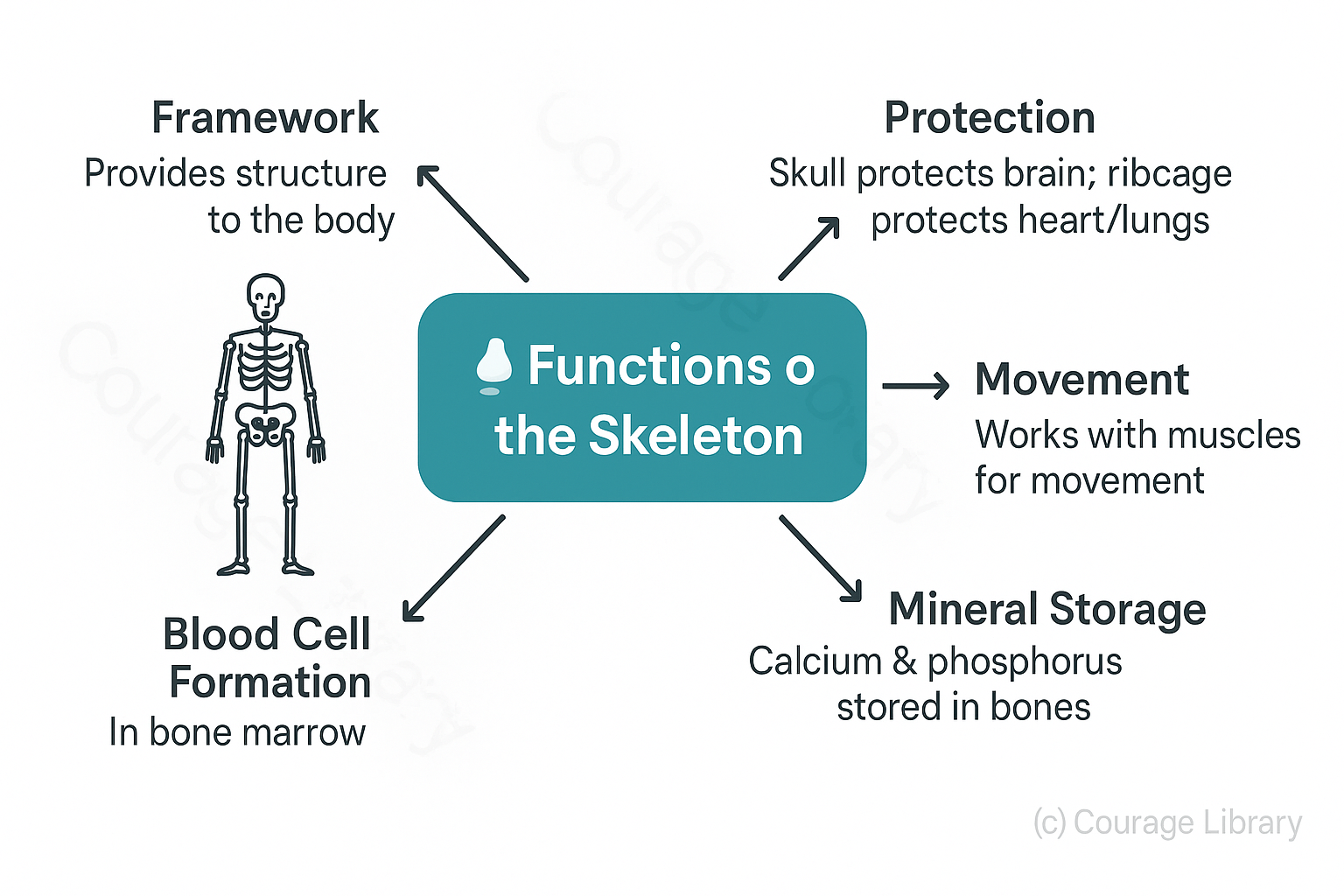SSC CGL - Detailed Guide 2025
Self-Paced Course

Skeletal and Muscular Systems
Reference: NCERT Class 10-12, Lucent GK
1. Skeletal System
The skeletal system provides shape, support, and protection to the body. It also enables movement in coordination with muscles.
A. Functions of the Skeleton
- Provides framework to the body
- Protects internal organs (e.g. skull protects brain, ribcage protects heart/lungs)
- Helps in movement (with muscles)
- Site of blood cell formation (in bone marrow)
- Stores minerals like calcium and phosphorus

B. Types of Bones
| Type of Bone | Description | Example |
|---|---|---|
| Long Bones | Longer than wide | Humerus (arm), Femur (thigh) |
| Short Bones | Cube-shaped, equal length and width | Carpals (wrist), Tarsals (ankle) |
| Flat Bones | Thin and broad, often curved | Skull, Sternum, Ribs |
| Irregular Bones | Complex shape | Vertebrae, Pelvis |
| Sesamoid Bones | Small, round bones in tendons | Patella (knee cap) |
Total bones in adult human body: 206
Axial Skeleton (80 bones): Skull, vertebral column, ribs, sternum
Appendicular Skeleton (126 bones): Limbs and girdles
C. Bone Marrow
Red Bone Marrow produces RBCs, WBCs, and platelets
Yellow Bone Marrow stores fat and can convert to red in emergencies
2. Muscular System
Muscles work by contraction and relaxation. Muscles are connected to bones via tendons.
A. Types of Muscles
| Type of Muscle | Control | Appearance | Location | Function |
|---|---|---|---|---|
| Skeletal Muscle | Voluntary | Striated, multinucleated | Attached to bones | Movement of body parts |
| Smooth Muscle | Involuntary | Non-striated, uninucleated | Walls of internal organs | Moves food, blood, etc. |
| Cardiac Muscle | Involuntary | Striated, branched, uninucleated | Heart only | Rhythmic contraction |
Muscles constitute about 40-50% of body weight.

B. Important Muscle Actions
Flexion: Bending (e.g. elbow flex)
Extension: Straightening
Abduction: Movement away from midline
Adduction: Movement toward midline
Rotation: Circular movement
3. Joints and Movement
A joint is the point of contact between two bones. Joints allow bones to move relative to each other.
A. Types of Joints
| Type of Joint | Movement Allowed | Example |
|---|---|---|
| Fixed/Immovable Joint | No movement | Skull sutures |
| Slightly Movable Joint | Limited movement | Vertebrae |
| Freely Movable Joint | Wide range of movement | Shoulder, Knee, Elbow |
Freely Movable Joints (Synovial Joints):
| Joint Type | Movement | Example |
|---|---|---|
| Ball and Socket | Movement in all directions | Shoulder, Hip |
| Hinge Joint | Movement in one direction | Elbow, Knee, Fingers |
| Pivot Joint | Rotation around axis | Neck (atlas and axis) |
| Gliding Joint | Sliding motion | Wrist, Ankle |
| Saddle Joint | Back-and-forth and side-to-side | Base of thumb |
B. Ligaments and Tendons
| Structure | Connects | Function |
|---|---|---|
| Ligament | Bone to Bone | Provides stability to joints |
| Tendon | Muscle to Bone | Transfers force from muscle to bone |
Synovial fluid in joints reduces friction and allows smooth movement.
Master Biology Concepts with Us!
Join Courage Library for comprehensive study materials and expert guidance.
Be a Couragian!